Michael Möhring and Klaus G. Troitzsch (2001)
Lake Anderson Revisited by Agents
Journal of Artificial Societies and Social Simulation
vol. 4, no. 3,
To cite articles published in the Journal of Artificial Societies and Social Simulation, please reference the above information and include paragraph numbers if necessary
<https://www.jasss.org/4/3/1.html>
Received: 19-Mar-01 Accepted: 8-May-01 Published: 30-Jun-01
nutrient: the amount of fertiliser and other nutrients in the lake, increased by fertiliser discharge, by respiration and decay of the biomass, and decreased by the growth of the biomass,
biomass: the amount of algae in the lake, increased by their growth, and decreased by their death rate, by respiration and, possibly, by harvesting algae,
detritus: the amount of sediment at the bottom of the lake, increased by dying algae, and decreased by detritus decay and, possibly, by dredging the lake bottom,
oxygen: the concentration of oxygen available to the algae for their metabolism; this level variable is composed of two parts, the epilimnion oxygen concentration (which is considered to be constant because the epilimnial oxygen is always replenished from the air above the lake surface) and the hypolimnion oxygen concentration which is increased by the diffusion of oxygen from the epilimnion into the hypolimnion, and decreased by the oxygen consumption (due both to the respiration of the algae and to the detritus decay process) and, possibly, by artificial aeration.
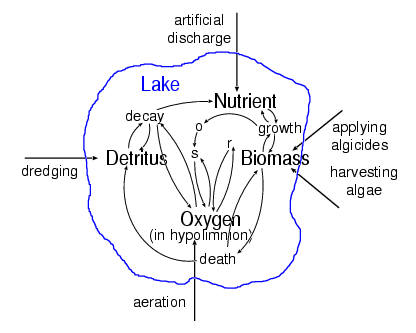
|
D: real := D_1 + DT * (DR_1 - DEC_1 - DREDG_1);
DR: death rate of the biomass
DEC: decay rate of the detritus
applying algicides: the application of algicides can increase the natural death rate of the algae,
dredging the detritus: the detritus can be dredged from the ground of the lake, which results in a decrease of nutrient (which otherwise would have been produced from the detritus naturally) and in an increase in the hypolimnial oxygen concentration (because less oxygen is consumed in the detritus process),
aeration of the lake: oxygen can be bubbled into the water of the lake, thus increasing the hypolimnial oxygen concentration,
harvesting algae: biomass can be harvested, thus decreasing the biomass (and, in consequence, its oxygen comsumption and its conversion into detritus); the harvested biomass can be used for agricultural purposes,
reducing nutrient (fertilizer) discharge into the lake: Anderson suggests an artificial discharge of fertiliser into the lake which is ten times the natural discharge of nutrient from outside the lake at the beginning of most of his simulation runs; moreover he suggests a yearly increase of the artificial fertiliser discharge of two per cent if no specific measures are taken.
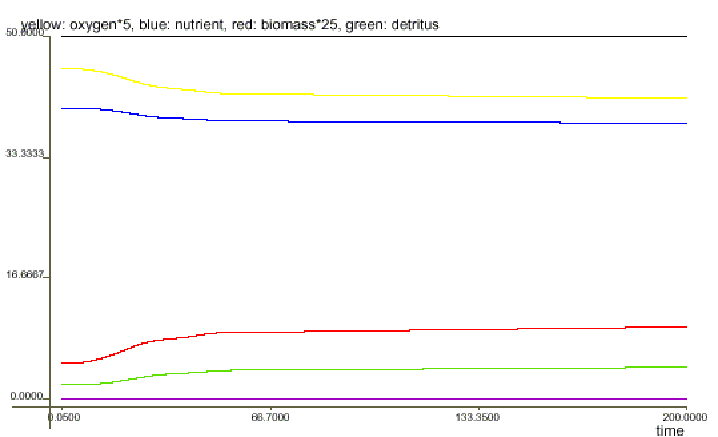
|
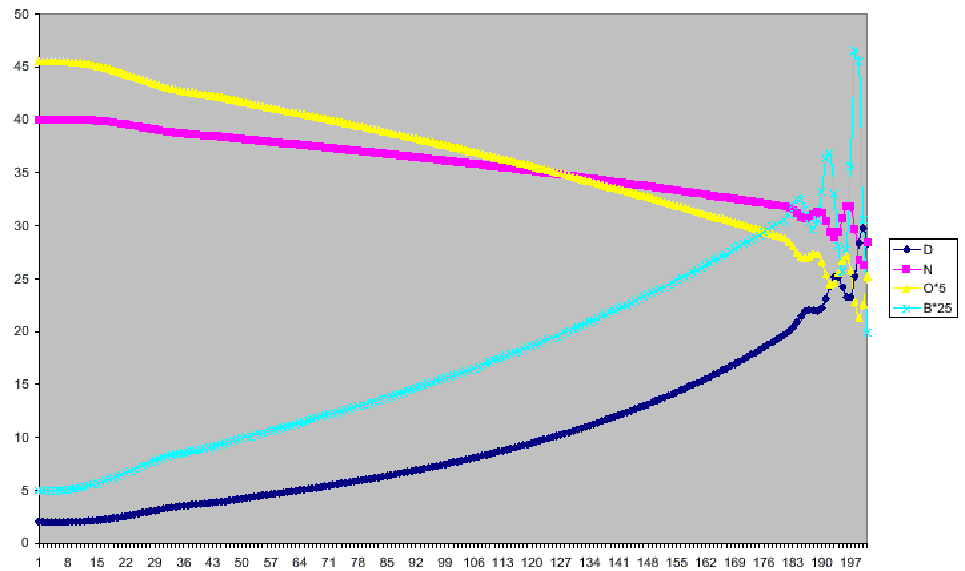
|
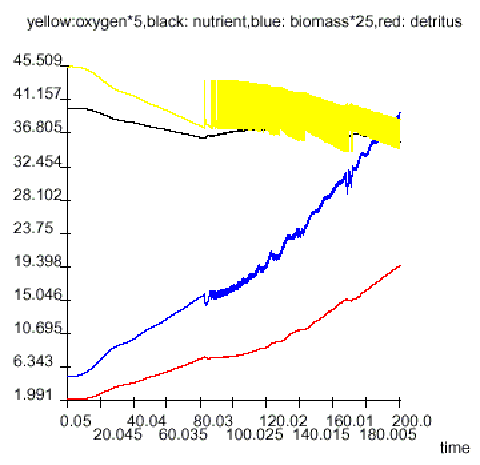
|
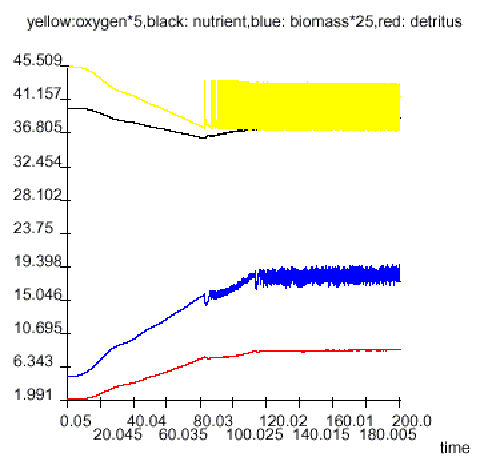
|
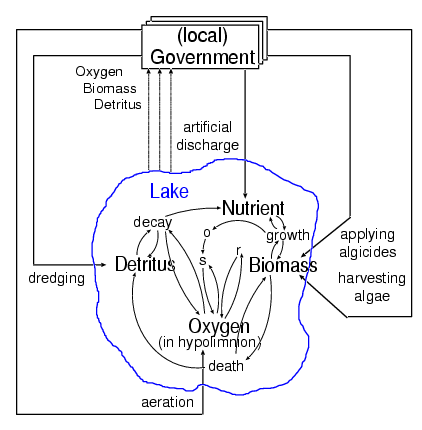
|
govt := {
/* Farming Rate: farming algae if biomass greater Bthresh */
FARM: real := max(0.0, FARMF * thisLake.B) if thisLake.B > Bthres
else 0.0;
Bthres : real;
/* Dredging Rate: dredging detritus if oxygen less Othres */
DREDG: real := DRDGF * thisLake.D if thisLake.O < OTHRES
ELSE 0.0;
/* DEATH RATE: APPLYING ALGICIDES IF OXYGEN LESS OTHRES */
K2: REAL := K2B if thisLake.O < Othres else K2A;
/* Aeration Rate: aeration if oxygen less Othres */
KA: real := KAER if thisLake.O < Othres else 0.0;
/* nutrient discharge increase rate */
NDIR : real := NDIR1 if thisLake.O > Othres else NDIR2;
thisLake : list of lake;
}
Nutrient discharge: reduced/increased (by 2 per cent per year) while oxygen is less/greater 7.5 - this makes it necessary to model the nutrient discharge in a more elaborated manner than with a table function
Harvesting: done/not done while biomass is over/less 0.75
Aeration: done/not done while oxygen is less/over 7.5 The total nutrient discharge, harvesting and aeration rates are calculated by the averages of the respective four government rates.
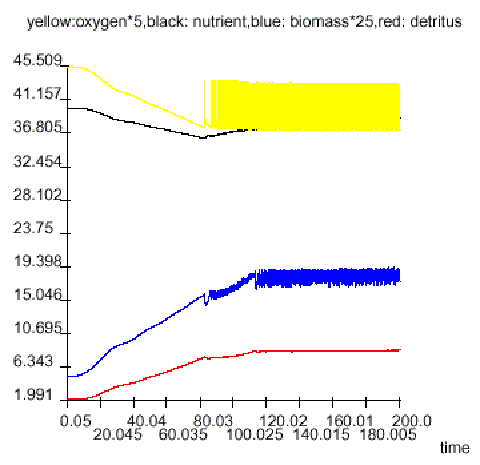 |
Nutrient discharge: reduced/increased (by 2 per cent per year) while oxygen is less/greater 7.5
Harvesting: done by two governments while biomass is over 0.5, done by the other two governments while biomass is over 0.75 (which is never reached in this experiment, so the two lazy governments never harvest)
Aeration: done/not done while oxygen is less/over 7.5
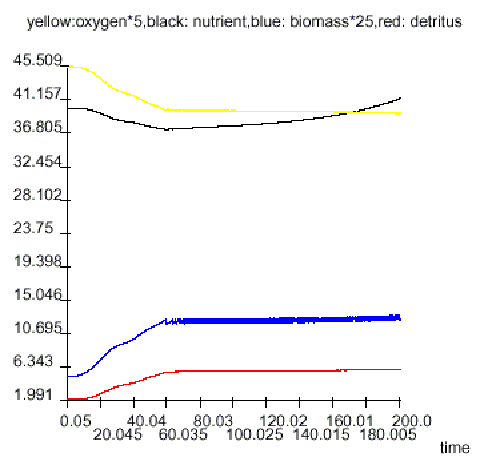
|
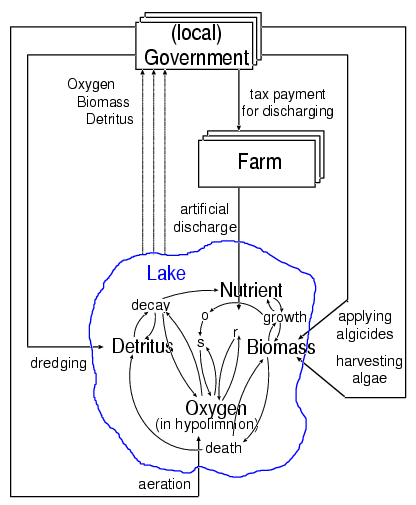
|
farm:= {
/* nutrient discharge increase rate */
NDIR : real := NDIR1 if TAXthres > auth.TAX else NDIR2;
/* individual tax threshold */
TAXthres : int;
auth : list of govt;
}
Tax raising: done (TAX=5)/not done (TAX=0) while oxygen is less/greater 7.5
Aeration: done/not done while oxygen is less/over 7.5
The behaviour of the thirty farmers is as follows:
Nutrient discharge: reduced/increased (by 2 per cent per year) if the government tax is higher/lower than the individual threshold each farmer can pay.
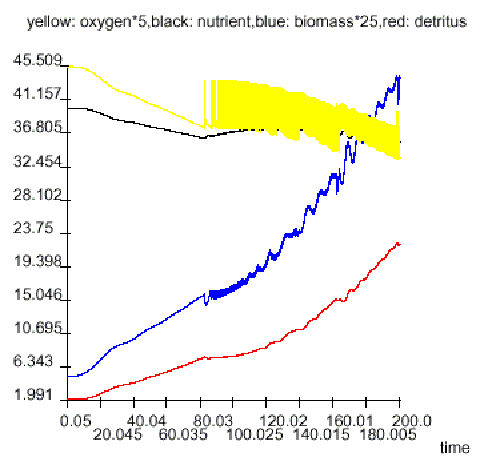
|
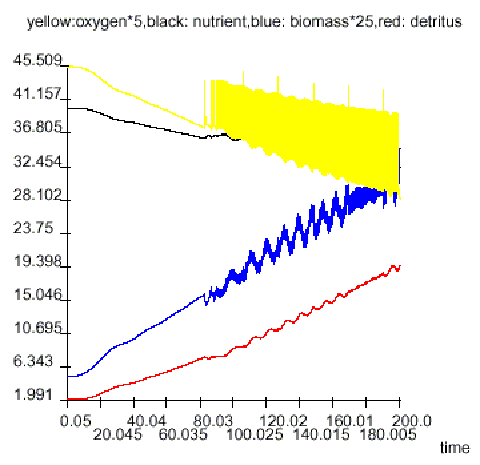
|
Tax raising: done (TAX=5)/not done (TAX=0) while oxygen is less/greater 7.5
Aeration: done while oxygen is less 7.5 and not done otherwise (aeration is restricted to a period of approximately two months at the beginning of a year).
Tax raising: done (TAX=5) while oxygen is less than 7.5 and not done (TAX=0) otherwise (but if the tax is ever raised it is never abrogated - which seems quite natural for real governments: the Imperial Government of Germany introduced a tax on champagne for funding the Imperial Navy before World War I, this tax still exists).
Aeration: done while oxygen is less 7.5 and not done otherwise, but aeration is restricted to a period of approximately two months at the beginning of a year.
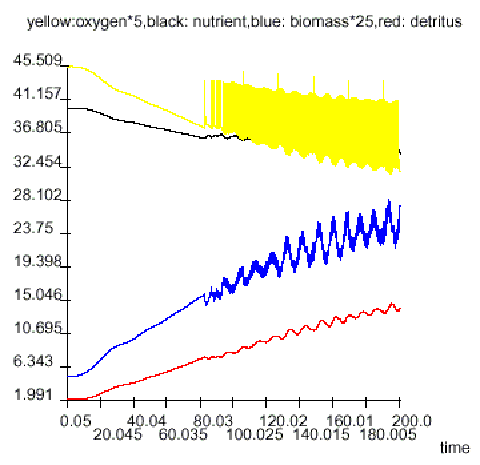
|
2 Jay M. Anderson: 'The Eutrophication of Lakes', in: Dennis and Donnella Meadows: Toward Global Equilibrium, Cambridge MA (Wright Allen) 1973, pp. 171-140
3 Stephen Carpenter, William Brock and Paul Hanson: 'Ecological and Social Dynamics in Simple Models of Ecosystem Management' Conservation Ecology 3 (2):4 1999, URL: http://www.consecol.org/vol3/iss2/art4
Return to Contents of this issue
© Copyright Journal of Artificial Societies and Social Simulation, 2001